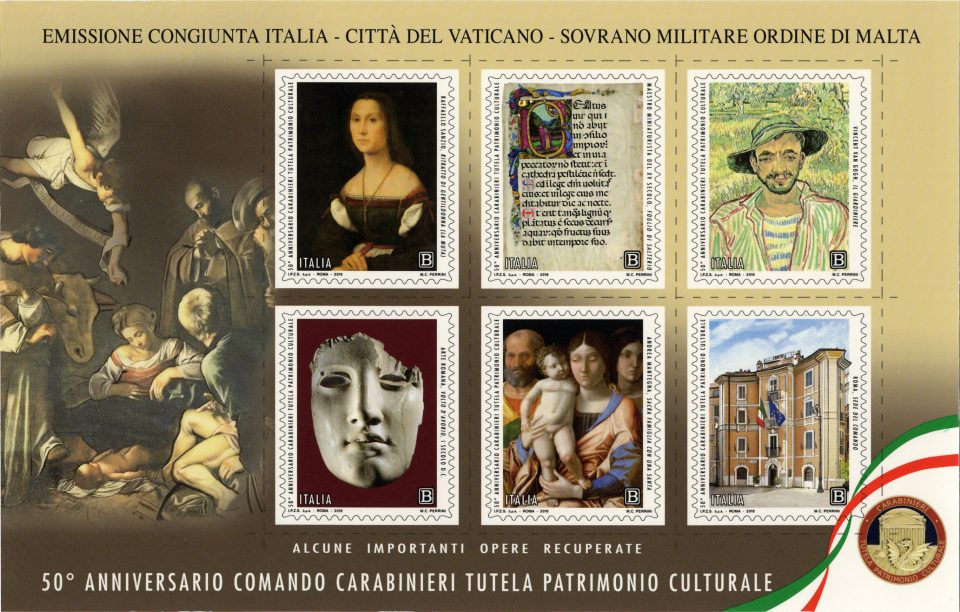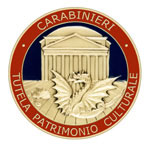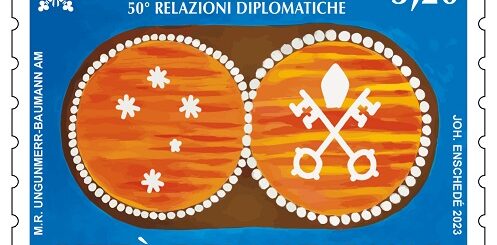POSTE ITALIANE 15^ emissione anno 2019 del 29 Aprile “foglietto con n.6 francobolli dedicati al Comando Carabinieri per la Tutela del Patrimonio Culturale, nel 50° anniversario dell’istituzione (emissione congiunta con la Città del Vaticano e il Sovrano Ordine Militare di Malta (S.M.O.M.)

Il Ministero ha emesso il 29 aprile 2019 dei francobolli ordinari appartenenti alla serie tematica “il Senso civico” dedicati al Comando Carabinieri per la Tutela del Patrimonio Culturale, nel 50° anniversario dell’istituzione, emissione congiunta con la Città del Vaticano e il Sovrano Ordine Militare di Malta (S.M.O.M.), relativi al valore della tariffa B, corrispondente ognuno ad €1.10.
Caratteristiche del foglietto: i sei francobolli sono disposti su due file e inseriti in un foglio fustellato; a sinistra, è riprodotta l’opera del Caravaggio denominata “La Natività con i Santi Lorenzo e Francesco d’Assisi”, trafugata, e ancora non ritrovata, dall’Oratorio della Compagnia di San Lorenzo di Palermo. Completa il foglio la riproduzione, in basso a destra entro una fascia tricolore, del logo del Comando Carabinieri per la Tutela del Patrimonio Culturale.
Caratteristiche dei francobolli, vignette: cinque dei sei francobolli, racchiusi all’interno di un foglio, riproducono altrettante opere recuperate dai Carabinieri per la Tutela del Patrimonio Culturale in 50 anni di attività. In particolare, da sinistra a destra partendo dall’alto: “Ritratto di gentildonna”, detto “La muta”, di Raffaello Sanzio, conservato nella Galleria Nazionale delle Marche – Palazzo Ducale di Urbino; Foglio di Salterio, conservato nell’Archivio Provinciale Ara Coeli in Roma; “Il giardiniere”, conosciuto anche come “Ritratto di giovane contadino”, di Vincent van Gogh, conservato nella Galleria Nazionale d’Arte Moderna e Contemporanea di Roma; “Volto d’avorio”, arte romana del I secolo d.C., conservato nel Museo Nazionale Romano – Palazzo Massimo in Roma; “Sacra Famiglia con una Santa” di Andrea Mantegna, conservato nel Museo di Castelvecchio di Verona. Il sesto francobollo raffigura il Palazzetto Raguzzini, sede storica del Comando Carabinieri per la Tutela del Patrimonio Culturale di Piazza Sant’Ignazio in Roma.
Il Comando Carabinieri per la Tutela del Patrimonio Culturale è un reparto speciale dell’Arma dei Carabinieri.

Venne fondato il 3 maggio del 1969 con la denominazione “Comando Carabinieri Ministero Pubblica Istruzione – Nucleo Tutela Patrimonio Artistico” allo scopo di tutelare il patrimonio culturale ed artistico dell’Italia.
Dipende funzionalmente dal Ministero dei beni e delle attività culturali e del turismo (MIBACT).
Struttura ed organizzazione
Il Comando, nella forma attuale, ai cui vertici vi è un generale di brigata, si compone di una struttura centrale e di una struttura periferica. Ha sede a Roma, in piazza Sant’Ignazio, 152. Il comandante attuale è il Generale di Brigata Fabrizio Parrulli.
La struttura centrale si articola in un ufficio comando e un reparto operativo, mentre la struttura periferica si compone di quindici “nuclei” e di una “sezione” ed è coordinata dal Vice Comandante del Comando Tutela Patrimonio Culturale, il Colonnello Alberto Deregibus.
Uno dei fiori all’occhiello del reparto è senza dubbio la “Banca dati dei beni culturali illecitamente sottratti”, gestita dal TPC per conto del MiBACT. Diversi servizi vengono offerti al cittadino sul sito carabinieri.it e sull’app iTPC. Tra questi, la possibilità di compilare l’Object-ID, una sorta di documento d’identità delle opere d’arte in proprio possesso, al fine di accelerare le pratiche in caso di furto delle stesse; la consultazione dei bollettini delle ricerche, la ricerca per immagini.
Attività
Il Comando è specializzato nelle indagini e nelle operazioni relative al patrimonio culturale italiano, avvalendosi di specifiche professionalità e di tecnologie d’avanguardia.
Nel gennaio 2015 con l’Operazione Teseo viene realizzato quello che è stato definito il più grande recupero di reperti ed opere d’arte della storia, recuperando 5.361 reperti risalenti ad un periodo che va dal 1.000 a.C. al III secolo D.C., con un’indagine che per anni ha attraversato numerosi Paesi ed operatori. Il Comando viene inoltre attivato anche per operazioni internazionali relative al patrimonio culturale in pericolo, con particolare riferimento alle distruzioni ed agli altri illeciti operati dall’ISIS dal 2014 in poi.
Nel luglio 2016, alla Galleria nazionale di arte antica presso Palazzo Barberini viene inaugurata la mostra “L’Arma per l’Arte e la Legalità” in cui vengono esposti alcuni dei tesori dell’arte recuperati in Italia e all’estero dal Comando TPC.
La Banca dati dei Carabinieri TPC non ha eguali al mondo contando circa 6 milioni di opere registrate ed è a disposizione di tutte le polizie del mondo.
Se sei interessato ad acquistare questo foglietto, lo puoi acquistare al prezzo di € 12.00. Inviami una richiesta alla email: protofilia1@gmail.com
POSTE ITALIANE 15th issue of the year 2019 of April 29 “sheet with 6 stamps dedicated to the Carabinieri Command for the Protection of Cultural Heritage, on the 50th anniversary of the institution (joint issue with the Vatican City and the Sovereign Military Order of Malta (SMOM)

On 29 April 2019 the Ministry issued ordinary stamps belonging to the thematic series “the civic sense” dedicated to the Carabinieri Command for the Protection of Cultural Heritage, on the 50th anniversary of the institution, joint issue with the Vatican City and the Sovereign Order Military of Malta (SMOM), relating to the value of tariff B, each corresponding to € 1.10.
Characteristics of the leaflet: the six stamps are arranged in two rows and inserted into a punched sheet; on the left, the work of Caravaggio called “The Nativity with Saints Lawrence and Francis of Assisi” is reproduced, stolen, and still not found, by the Oratory of the Company of San Lorenzo in Palermo. The reproduction of the Carabinieri Command for the Protection of Cultural Heritage is completed in the bottom right corner, within a tricolor strip.
Characteristics of the stamps, vignettes: five of the six stamps, enclosed within a sheet, reproduce as many works recovered by the Carabinieri for the Protection of Cultural Heritage in 50 years of activity. In particular, from left to right, starting from the top: “Portrait of a Gentlewoman”, called “La muta”, by Raffaello Sanzio, preserved in the National Gallery of the Marche – Palazzo Ducale of Urbino; Psalter Sheet, kept in the Ara Coeli Provincial Archive in Rome; “The Gardener”, also known as “Portrait of a young peasant”, by Vincent van Gogh, preserved in the National Gallery of Modern and Contemporary Art in Rome; “Ivory Face”, Roman art of the 1st century AD, preserved in the National Roman Museum – Palazzo Massimo in Rome; “Holy Family with a Saint” by Andrea Mantegna, preserved in the Museum of Castelvecchio di Verona. The sixth stamp shows the Palazzetto Raguzzini, the historic headquarters of the Carabinieri Command for the Protection of Cultural Heritage in Piazza Sant ‘Ignazio in Rome.
The Carabinieri Command for the Protection of Cultural Heritage is a special department of the Carabinieri.

It was founded on 3 May 1969 under the name “Carabinieri Ministry Public Education Command – Core of Artistic Heritage Protection” in order to protect the cultural and artistic heritage of Italy.
It depends functionally on the Ministry of Cultural Heritage and Activities and Tourism (MIBACT).
Structure and organization
The Command, in its current form, at the top of which is a brigadier general, consists of a central structure and a peripheral structure. It is based in Rome, in piazza Sant’Ignazio, 152. The current commander is Brigadier General Fabrizio Parrulli.
The central structure is divided into a command office and an operational department, while the peripheral structure consists of fifteen “nuclei” and a “section” and is coordinated by the Deputy Commander of the Cultural Heritage Protection Command, Colonel Alberto Deregibus.
One of the flagships of the department is undoubtedly the “Database of illicitly stolen cultural assets”, managed by the TPC on behalf of the MiBACT. Various services are offered to the citizen on the carabinieri.it website and on the iTPC app. Among these, the possibility of compiling the Object ID, a sort of identity document of the works of art in its possession, in order to speed up the practices in case of theft of the same; consultation of research reports, research by images.
Activities
The Command specializes in investigations and operations relating to the Italian cultural heritage, making use of specific professional skills and cutting-edge technologies.
In January 2015, Operation Teseo is the site of what has been called the greatest recovery of artifacts and works of art in history, recovering 5,361 finds dating back to a period ranging from 1,000 BC. to the third century D.C., with a survey that for years has crossed many countries and operators. The Command is also activated for international operations related to the cultural heritage in danger, with particular reference to the destruction and other illicit operations operated by ISIS from 2014 onwards.
In July 2016, the exhibition “L’Arma per l’Arte e la Legalità” was inaugurated at the National Gallery of Ancient Art at Palazzo Barberini, where some of the art treasures recovered in Italy and abroad by the TPC Command were exhibited.
If you are interested in buying this leaflet, you can buy it for € 12.00. Send me a request to the email: protofilia1@gmail.com

- data/date 29 Aprile 2019
- dentellatura/serration 11
- stampa/printing fustellatura/rotocalco
- tipo di carta/paper type bianca patinata neutra
- stampato I.P.Z.S. Roma
- tiratura francobolli 1.800.000
- foglietti 300.000
- formato foglietto 220 x 140 mm
- dimensioni/dimension 40 X 48 mm
- costo/price B = €1.10 x6
- bozzettista
- num. catalogo / catalog num. Michel 4106-4107-4108-4109-4110-4111 YT 3867-3868-3869-3870-3871-3872 Unif. 3949-3950-3951-3952-3953-3954






